The part pop and part Dada party that is Neil Edwards’ work never fails to be wonky and rarely succeeds in right angles. Staying true to himself, the frustrated comedian comes out in his illustrations, zines and collages.
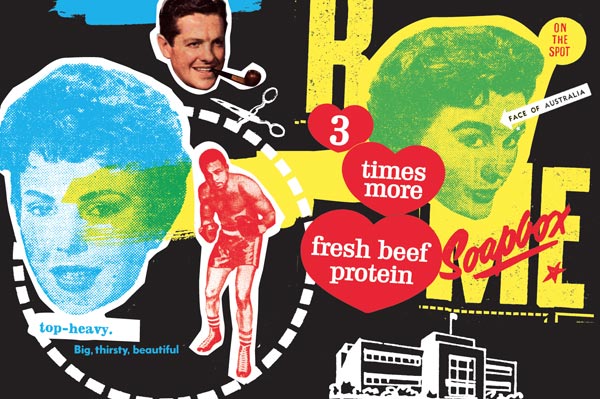

The Face of Australia, Double page spread from Crap Book, 2010
Where does the name Mr. Edwards come from?
I come from a long line of Mr. Edwards. Add that to a complete lack of imagination and voila! I used to train at a dojo where etiquette dictated that everyone call each other Mr. or Ms., followed by their surname. Even when we socialized after training we kept up the formal address. I think we all found it amusing. I suppose it has authority and a bit of gravitas that I obviously thought I needed when I started. Anyway it kind of stuck. At my first job, working on i-D Magazine, we moved offices to Shoreditch from Covent Garden and somehow two photographers’ portfolios got lost in transit. I think they had been put in black plastic bin liners to keep them safe. i-D operated on a shoestring back then, and one of the photographers wanted quite a bit of money as compensation. She sent round two very large gentlemen who pointed out in no uncertain terms that they would come back every day until they got it. They left a mobile number, they were both called Mr. Brown. There was a hint of menace in the way they said it. Maybe it made an impression on me.


Brains
Digital Image
Unpublished
2011
How and when did you get into art? Were you into it as a kid?
My dad was a screen printer for a chain of East End supermarkets called Cater Bros. He would print show cards bearing the legend “Beans 2p off’ etc. During school holidays I would occasionally go in and earn pocket money by sorting all the old metal type back into the right trays. My dad used to bring home promotional posters from ink companies. I particularly remember a print of Scotland Forever – the charge of the Scots Greys by Lady Elizabeth Butler – and lots of blank paper. I used to draw a lot. My mum was particularly good at colouring in. At a holiday camp I won a prize for a drawing of a football match. I did art at school but there was not much teaching at all, I vaguely remember a still-life, but mainly the other kids ate the glue until they were old enough to sniff it.
I went to a particularly rough school with a reputation in the area. It was not uncommon to see police helicopters hovering over pitched battles with other schools. Art wasn’t seen as a proper subject as we were being groomed to work at the Fords factory in Dagenham. The only reference material was a stack of Stern magazines, which was a bizarre mix of photographic material. A typical story would have a lot of bare chested young ladies and then perhaps a photo of a headless torso washed up on a beach. The fact that it was all in German added to the mystery.
I did start to get into photography though, and did a bit of technical drawing. In the sixth form I used to draw caricatures of teachers and pupils. I was one of three students in my year that studied French. My French teacher was the only good teacher I had and being such a small group, she took us to see French new wave films and to see the impressionists at the Courtauld Institute. I also got into French bande desinees like those from Fluide Glacial and Metal Hurlant with artists such as Frank Margerin, Marcel Gotlib, André Franquin and Moebius. However I didn’t really think about art as a career until one day a girl in the sixth form announced she was applying to St. Martins School of Art. It was like a light went on. I applied too but I didn’t have a portfolio of work so they advised me to apply to my local college to do a foundation course and then re-apply for the degree course.
I applied to the local college at East Ham and had a great interview talking about the Spanish Civil War and Jack Kerouac, they told me I was just the kind of student they were looking for until they asked to see my work. The head of the course said “Jesus Christ! It’s not a lot is it? I can’t let you on the course as it makes a mockery of the whole interview system.” He told me to go away and do some large charcoal drawings from my bedroom window, bring them back and he would reconsider. I got on the course, then got on the degree course at St. Martins (a working knowledge of the Spanish Civil War opened a lot of doors in them days) and then went to the Royal College of Art, which really put me off. Fortunately I got a job at i-D Magazine where I met Terry Jones and Stephen Male and that got me excited about art and design again.
…they told me I was just the kind of student they were looking for until they asked to see my work. The head of the course said “Jesus Christ! It’s not a lot is it? I can’t let you on the course as it makes a mockery of the whole interview system.”
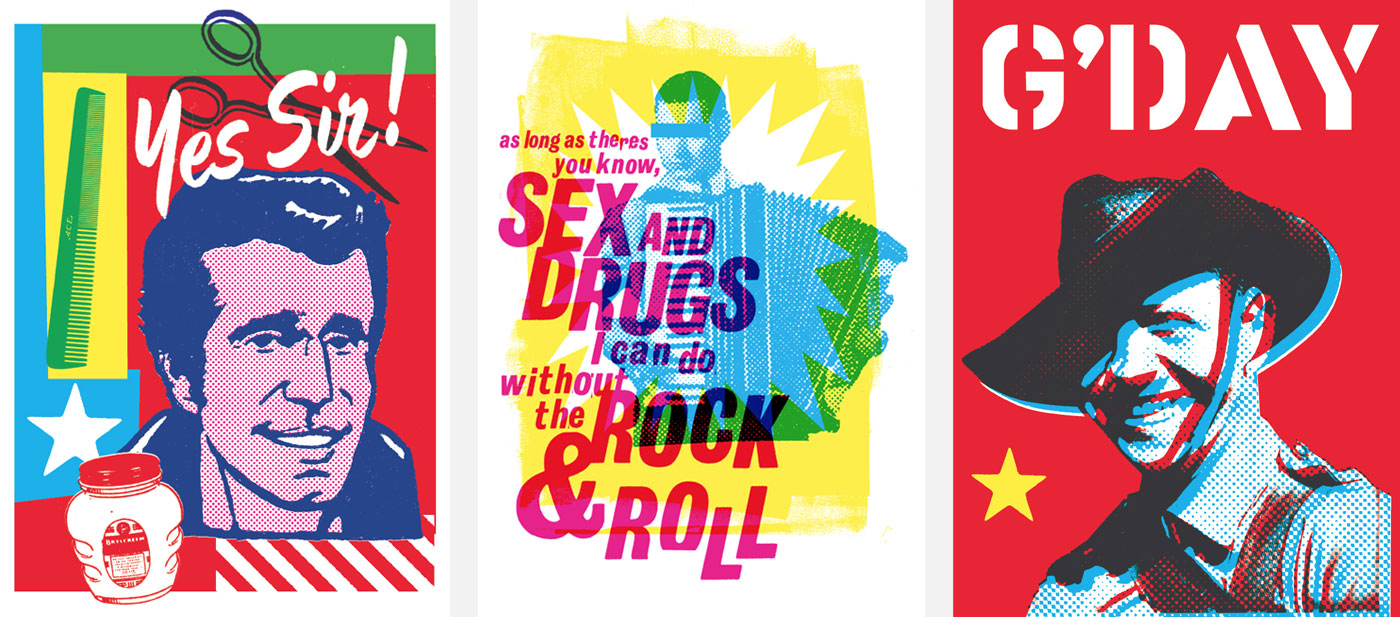

Yes Sir! 3 Color Screen Print, 500 x 700mm, 2013
Sex and Drugs and Rock And Roll, 3 Color Screen Print, 500 x 700mm, 2013
G’day, Self Adhesive Sticker, 148.5 x 105mm, 2011
So, did art and design come easy to you after you had taken some classes? Or have you always had to work hard for it?
It depends on what you mean by classes. At college perhaps an industry professional would come in to talk about what they do, show you some of their work and then set you a brief – say, design a record cover. Then they would come back two weeks later, and look at what you had done and give you some feedback. Someone else would come in one day a week and wander round the studio and if you were lucky come and talk to you about what you were working on. The art school experience is about finding yourself (you won’t find any tutors). I used to learn from the other students. It was only when I started work that I started to really learn any skills. I am still unemployable though. For me a project starts off as panic, and then through a process of confusion and frustration miraculously it ends up finished.
I am a frustrated comedian so it seems natural to put a humorous spin on things. It’s just the way I am.
What’s the relationship between humor and art?
I am a frustrated comedian so it seems natural to put a humorous spin on things. It’s just the way I am. But now that I think about it, it could simply be that when I was growing up, if you were working class, your exposure to art was comics, cartoons, the Terry Gilliam bit on Monty Python – all vaguely humorous. My mum used to go on about “Andy Warhol and his baked bean tin” and Carl André’s “pile of bricks” as being rubbish. Art was a source of ridicule.
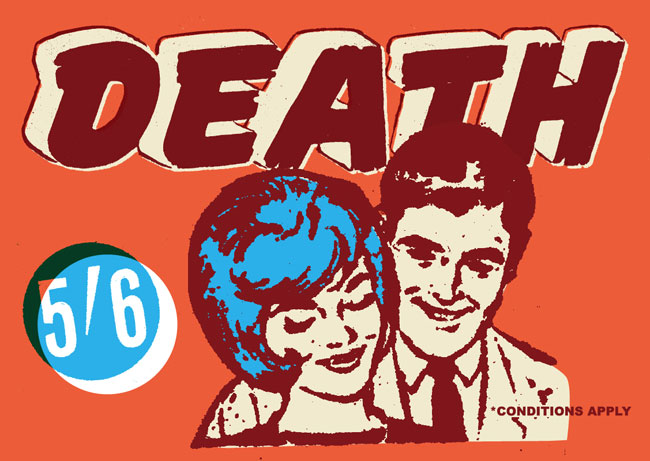

Do you have a favorite joke?
I do but it doesn’t really work just written down, but I heard this one recently from a friend who lives in the U.S. A rich man, a white man and a black man sit down for coffee. On the table is a plate with 12 biscuits (cookies I believe you call them). The rich man takes 11 of them, then leans over to the white man and whispers, watch out or the black man will steal your cookie.
What do you think of American art and design?
I think it’s a great idea. I tend to go for the Charles Anderson, Chip Kidd and Art Chantry end of town and I like Charles Wilkin’s collages too.
I don’t really think in terms of American art and design as if it’s a particular genre, like Dutch design, which has a distinct look about it. I think about it like American comedy versus British comedy. It’s all very competent and everything, but just missing a little spark of the unusual.
Where does your source material come from?
Packaging, magazines, overheard conversations. I once spent New Year’s Day in Amsterdam with a screaming hangover, fishing spent fireworks out of the gutter and then going back to my hotel and soaking all the labels off. When I was at college after a night on the ale, my mate Richard and I would go round the back of Holborn Underground station where there was a fruit barrow and rummage through the wooden fruit crates taking cardboard labels and also from badly screen-printed wooden panels. I am a great collector of printed tat from a time before there was the technology to reproduce quality colour photography. Everything was drawn or hand-lettered. I am addicted to foreign supermarkets, flea markets, junk shops, and car boot sales.
Walk us through your process.
My work revolves around found images. For some bizarre reason, drawing something myself seems like cheating. I trawl through my collection of images and see if there is anything that fits the theme I am working on, or if I have a bee in my bonnet about a particular image I want to use I will try and work that in. I take things out of context and then combine them with other bits of found type or images to create a new meaning. I will just potter about until something sticks. Then I spend a lot of time trying to make it look like it’s not done on a computer, putting colours out of register, making sure things aren’t lined up or are slightly wonky. Right now I am also gearing everything up for screen printing so it will be CMYK. I tend to think in terms of a print outcome.


Countdown
Digital print on paper
297mm x 420mm
2012
I feel so guilty about cutting up old magazines… I have magazines that are 80 years old, and they may be the last ones in existence. How can I cut them up?
Do you prefer digital or hand-made collages, and why?
They both have their merits. You wouldn’t think it to look at my work but I am a bit of a perfectionist, so using the Mac is much faster. You can create multiple variations to compare, change scale, colour, etc. Then of course that’s exactly why I like hand-made collages because it’s more disciplined and the size and scale and colour of what you have dictate how the finished piece ends up. It is so much more authentic and it’s a one-off.
I feel so guilty about cutting up old magazines, my collection started with a lot of old mags of my parents that I found in the cellar. I have magazines that are 80 years old, and they may be the last ones in existence. How can I cut them up? I have some which are particularly tatty so I may cut those up. Also National Geographic, you see those in every secondhand bookshop so there are loads of those around. I used to keep sketch books which were really glorified scrap books where I would paste in bits of found type and images and make collages, but it was incredibly labour-intensive. I have been making A5 zines digitally as a way of playing with ideas quickly. I am working through the “pop” series where each zine is prefixed by the word pop: Pop Gun, Pop Corn, Pop Tarts and Pop Sox with Pop Eye, Pop Stars, Pop Up, Pop Sickle, Pop Music, Pop Art, Pop-Omatic, Pop In and Pop Culture is in the pipeline.
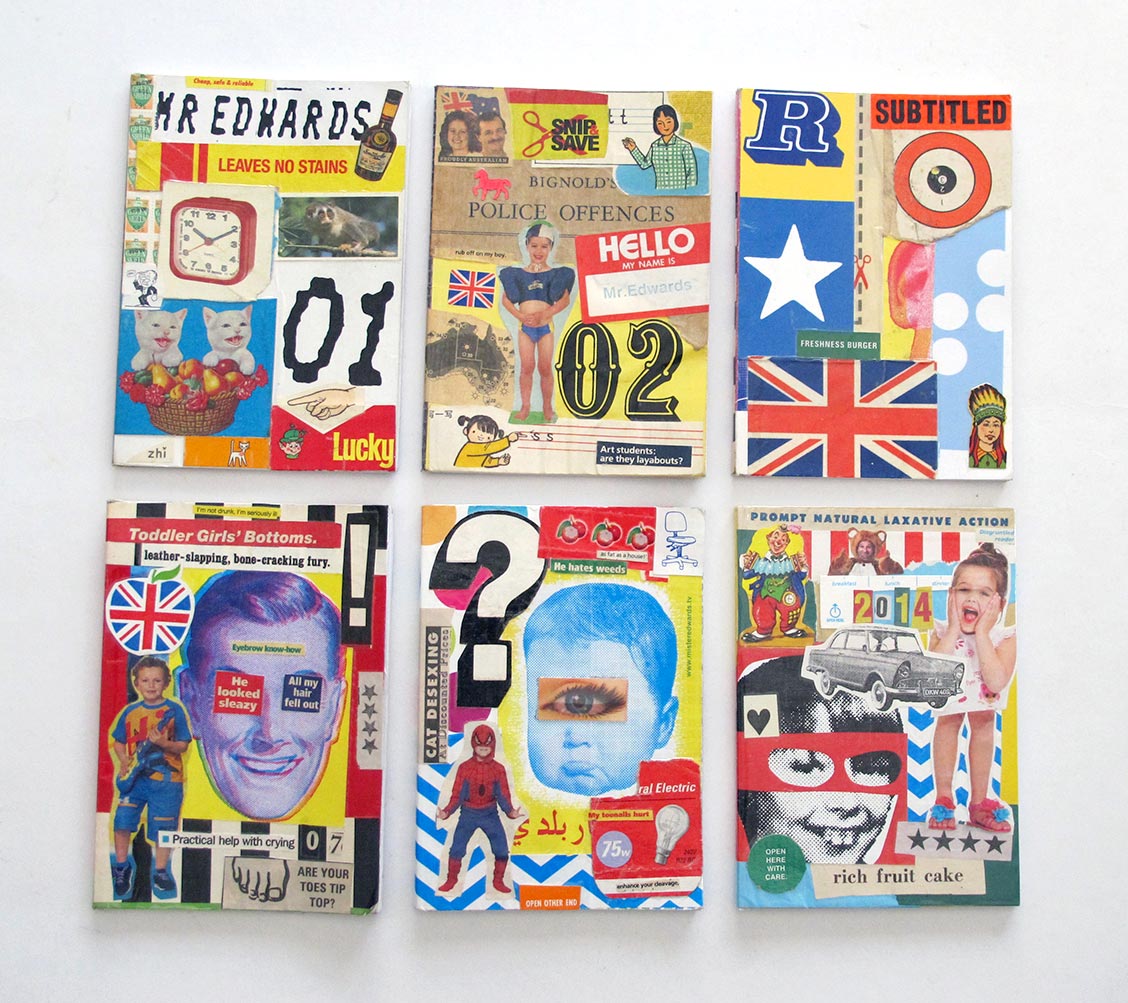

Diary Covers
Mixed Media Collage on Collins Student Diaries
150mm x 210mm
2001-2014
If Pop Art had a wild party with the Dadaists, it’s what the room would look like the next morning.
Tell us a little about your Diaries.
Funny you should ask because every year I buy the same brand of cheap student diary and then customize the cover with a collage. I like the format inside but the covers are pretty horrible so I started covering them. Now I go out of my way to get one. This year I got worried because I couldn’t find any for ages. They are pretty boring inside – meetings and reminders and deadlines etc., except for a phase where I started writing my dreams down. By the way, did you know that dates are distributed in the same way across 1986 and 2014, meaning that if you have a 27-year-old calendar knocking around you can re-use it! …and some people say I’m just a pretty face.
How would you describe your work to someone who couldn’t physically see it?
It’s brilliant. Buy some. If Pop Art had a wild party with the Dadaists, it’s what the room would look like the next morning.
How do your surroundings effect what you make?
I am opportunistic, I used to have access to free colour printouts so I started printing zines and paste ups, now I have access to screen printing so I am making tee-shirts and posters. As far as environment is concerned, I like being surrounded by cases full of stuff I have collected and a library of old magazines and books, but once I get lost in the work I could be anywhere. I tend not to listen to music but I can sit in front of the TV with a laptop quite easily. I can work anywhere if it’s just me and the screen, but if it’s hands-on I need a bit of space. I tend to cover every available surface.


Popcorn Zine, 2011, 16 Pages, Digitally Printed, 148.5 x 210mm
Pop Tarts Zine, 28 Pages, Digitally Printed, 148 x 105 mm, 2012
What is the art and design environment like in Sydney?
Design-wise it’s very commercially-orientated with companies that think an app is an “idea.” It’s more marketing than design. Melbourne is the more arty city. Having said that, on the art front there is a lot going on in Sydney – Biennale of Sydney, Art and About, Vivid festival….er…we’ve had that big inflatable duck here….I need to get out more.
How does your personal work compare to working with clients?
When I’m working with clients I am usually trying to solve a problem, convey an idea or fit a particular space; whereas personal work I don’t really have any criteria except to create something I like, so it is a chance to experiment.
What is your favorite project or piece you’ve worked on to date, and why?
I was part of an exhibition of street art on Cockatoo Island in Sydney Harbour called Outpost. I was involved with the “paste modernism” room curated by Ben Frost, which was a collaboration of over 300 artists. Images were pasted over the top of one another in a fairly haphazard way. The room was like a huge collage. Cockatoo Island itself is an old naval base in the middle of the harbour and has amazing semi-derelict industrial buildings that make a great gallery space, especially for street art. You have to get on a ferry to get there so it’s quite an experience. It was good to be part of something bigger and to meet so many like-minded artists. The event was a huge success.
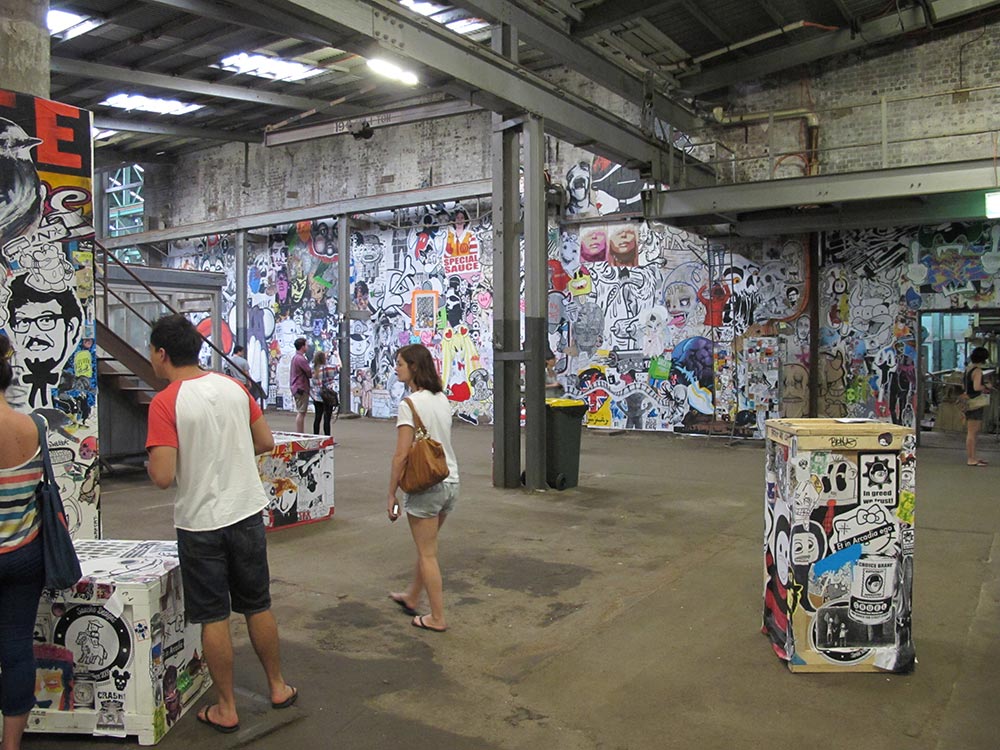

Paste Modernism
Outpost Project
Wheat Paste Ups on Wooden Panelling
Cockatoo Island, Sydney
2011
What do you like/dislike about being an artist?
The hours are good. You have no one directing you, but that can be good and bad. I constantly ask myself, Is this anything? Or is it rubbish? You need a certain amount of self-belief.
What can you always lose yourself in?
Old magazines. At St. Martins School of Art they had a cupboard in the library full of bound copies of LIFE and Picture Post from the 1930s through to the 1960s. I used to spend afternoons just leafing through them and photocopying old adverts. The only technology available to me then was the photocopier so I looked for images that had already been halftoned or were high contrast black on white as they were easier to reproduce. I am still drawn to this type of imagery.
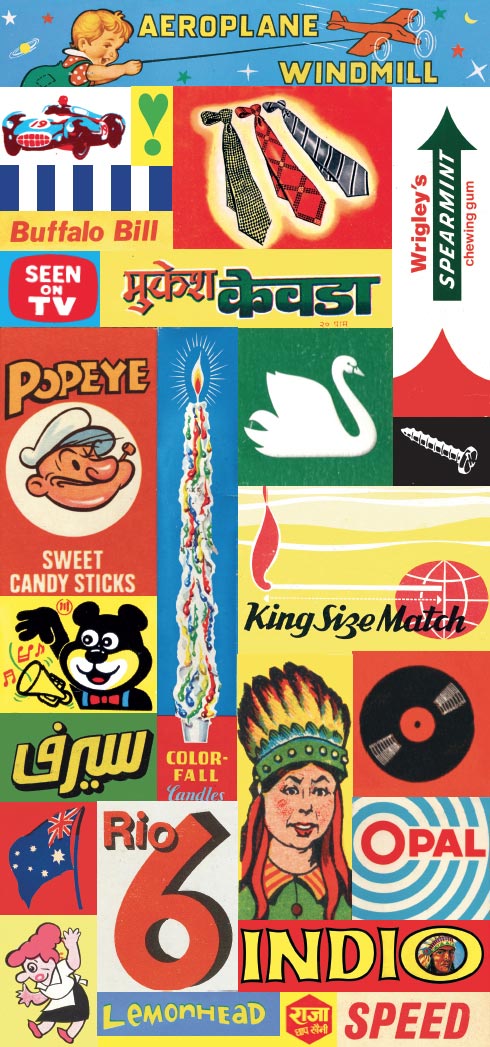

Rio 6
Digital Print on Paper
297 x 420mm
What’s something you’re glad your parents taught you?
How to disable an armed attacker with a ball point pen.
What are some ways – good and bad – the art world has changed since when you first started?
The Internet, social media and digital photography have generated a huge boom in street art. Anyone can be an artist and anyone can have their own gallery. Art used to be a bit highbrow but now it is instantly accessible to everyone. There are so many galleries online where you can buy art prints, it is overwhelming. There is so much competition.
When I first left college, there were no “design” books as such and art books tended to be confined to just the big names. In my nearest bookshop, Kinokuniya, there is a whole wall dedicated solely to books on street art. Magnation is a two story shop selling nothing but art and fashion magazines. There is a wealth of small publishers like Nobrow that are giving exposure to a wide spectrum of artists. There has been a resurgence in crafts like letterpress, sign writing and screen printing, which I see as a healthy reaction to the digital revolution.
What advice would you give young artists?
Be true to yourself. If you create something you don’t really like in order to try and please other people and they don’t like it, nobody is happy. But if you create something that you like and nobody else likes it, well, at least one person is happy.


Pakamac Girls
Digital Collage
Unpublished
2009